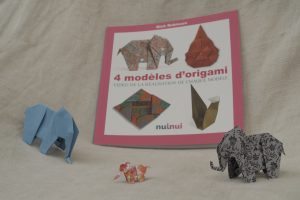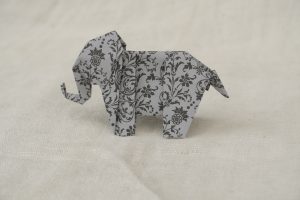I’ll give recommendations to buy paper, because it took me a while to discover where to find each kind, and I just stumbled upon another shop yesterday, so maybe I could get some hints from readers too :)
I’m not sponsored by any of those shops (although, if you want to send me free paper, we can be friends!). It’s just a guided tour of what I’ve found so far on the Internet. Of course, if you do leave your home sometimes, there are plenty of papershops in most cities – but I definitly enjoy receiving them in my mailbox :)
The first reference, since I’m in France, is of course origami-shop. They have a large selection of special papers (lokta, origamido, elephant hide, and so many other textured paper, huge sheets, and many other wonders). Honestly, I haven’t bought many of those yet, I don’t consider my level to be worth spending that amount of money in paper, but they also have all the basic colored (single face or duo) and patterned paper, book+paper kits, etc. They also have books, but I mostly buy mine second-hand on amazon, since it’s cheaper. But for papers, their prices are most of the time lower than everywhere else :) I particularly recommend the nuinui collections of patterned papers, amazing – and if you don’t have one, spare 2€ to buy a paper cutter, it changed my life. The test sheets were a bit disappointing though, not perfectly square. I ordered there 3 times, and was really satisfied each time. The founder (?) Nicolas Terry is an origamist, and knows what he sells :) I had a few questions that were always answered very fast by email.
The other French shop that I found yesterday (yay!) is papiergami.com. They have what origami-shop doesn’t have: full sheets of gorgeous japanese paper (chiyogami and katazome), and the cheapest small sheets of those I found (boxes of 200 sheets in 6cm, and packages of 100 sheets in 7,5 cm). Their Tant paper is cheaper than from origami-shop, but they don’t have the bigger sizes and they do have shipping costs, so it depends what you need. I haven’t completed an order there yet, so I’ll let you know how it goes – but I have bought on ebay second-hand paper from them, that are magnificent.
From Germany, but the shipping costs are not much higher, there is schoene-papiere.de. I don’t like the website, it’s really confusing (they are also less specialized in origami), but they have a huge selection of papers. They have glassine paper, cheap and beautiful packs of double-sided kraft paper, and in the offers you find bigs packs of cheap colorfull patterned Folia paper. They have a few japanese chiyogami sheets, but expensive. They have other weird japanese papers that I haven’t ordered yet but seem gorgeous. I ordered there once, and was satisfied with the order – except for the single-color Folia paper packs, the colors are hideous and fade fast (the patterned are good, though).
In England, there is Color Tree LTD. The shipping costs to France are high, but they have products from Jong Ie Nara, a paper company from Korea that makes beautiful and cheap origami paper, not easy to find in France. I have a box of 500 sheets double-sided paper in many colors, a box of foil / hologram paper, and a box of traditionnal Korean patterns – all of which you usually buy a few at a time for a high price. The sheets are thin, so it’s good for animals and modulars, not so much for boxes. They are also on ebay and amazon, the shipping costs are somewhat similar but sometimes they don’t sell the same items in the different places, so it’s worth checking each. I ordered there once, bothered them by email to have all the products I wanted on the same site, they were very helpfull.
I ordered also from Creativ Company in Germany, they don’t have much choice but the Vivi Gade collections are cheap and pretty (ordered origami paper and double-sided wrapping paper to cut in large sheets), and I am really happy with it.
I also order scrapbooking paper, because they make thicker paper in 30X30cm that are perfect for bigger boxes. After much comparing, I found Artemio is a brand that makes really cheap huge packs of assorted patterned paper. Beware, some scrapbooking paper is in fact cardboard and won’t fold well. Also, it seems to be a hobby for rich people, sometimes the prices are terrifying.
I obviously also order paper from ebay and amazon, in particular Aitoh, Daiso, and some other kinds of origami paper, which are not on the above websites. What is sure is: order from amazon.fr and not amazon.com, the shipping costs are better ; and order from ebay.com and not ebay.fr, the prices are less crazy.
So, my favorite amazon sellers are: Takeharu&affiliate_banner_id=15 Mori for the huge lots of square yuzen washi paper ; LEWTHWAITEmusicUK for the recycled partition paper ; Bic Warehouse, Japan-subcultures, Sukiyaki, wakuwaku Japan for papers from the US or Japan (shipping costs are low but it takes a while to arrive ; I’m poor and patient).
On ebay there are good deals with the bids, but most often than not the prices are higher than in the shops listed above. Also, I’m always surprised to see that people bring the bids higher than the buy-it-now price ^^
If you’re in the US, the Paper Place has beautiful Chiyogami. Anglesey Paper Company has Lokta paper. The shipping costs discouraged me from ordering, but they’re probably interesting for locals. There are many others, but I don’t have them in my bookmarks.
Beware, I’ve been known for falling in time-warps looking at somptuous paper, it might be contagious ;)


